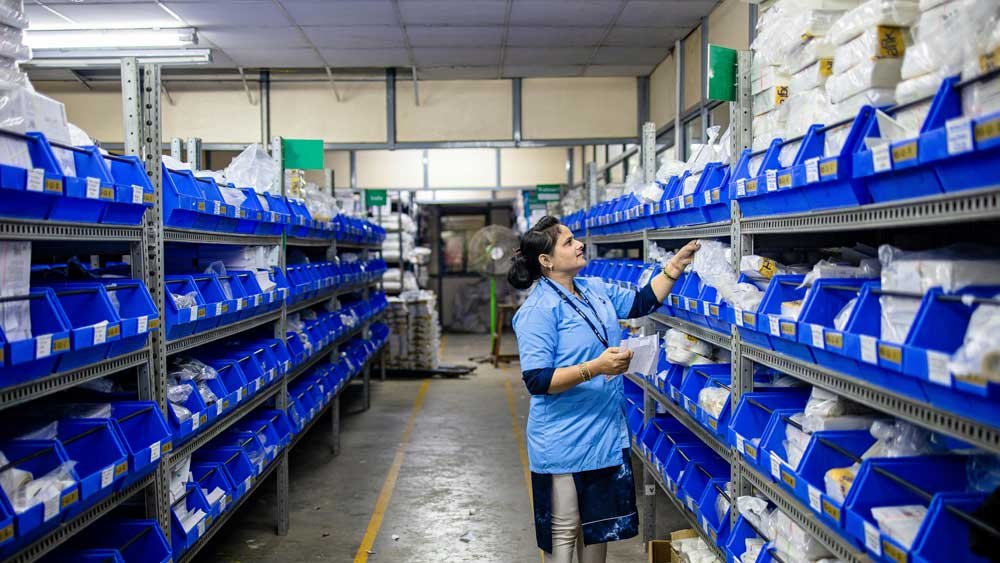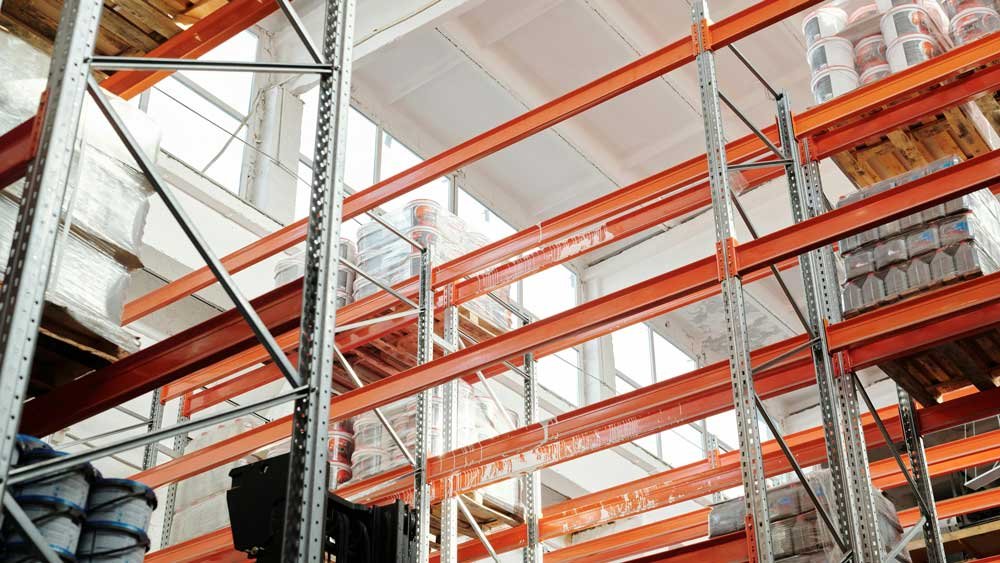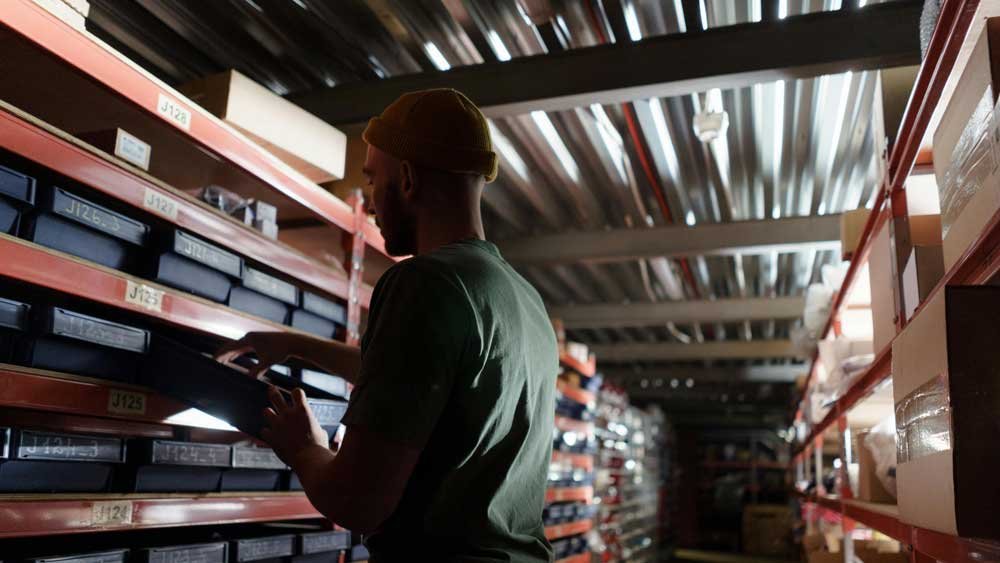In today’s rapidly changing business world, efficient warehouse storage is crucial for any enterprise. It’s not just about stacking goods; it’s a key component in optimizing supply chains, reducing operational costs, and boosting customer satisfaction. A well-organized, efficiently run warehouse ensures inventory accuracy, speeds up order fulfillment, and maximizes the use of valuable space.
However, when it comes to warehouse storage solutions, many people often encounter a common yet confusing question: What’s the difference between racking and shelving? While both are structures used to store items, they have significant differences in design, function, and optimal application scenarios. Not understanding these distinctions can lead businesses to choose the wrong storage system, thereby impacting warehouse efficiency, wasting space, and even posing safety hazards.
So, the following content will delve into the core differences between racking and shelving, helping you clarify these concepts and find the most suitable storage solution for your warehouse.

Racking vs. Shelving: Core Differences Explained
Load-Bearing Capacity: Why the Difference?
Load-bearing capacity is their most fundamental distinction, primarily stemming from their different design philosophies in structure and materials.
Racking (Heavy-Duty Racks):
- Structure: Heavy-duty racking is engineered to handle massive loads and resist powerful forces. Think of it as a robust skeletal system made up of sturdy uprights (the vertical posts) and strong beams (the horizontal supports). These core components, along with various support elements like bracing and cross-bracing, create an unyielding, rigid frame.
- Material: Generally, high-strength steel is used, such as cold-rolled special steel. These steels are thicker and have more complex cross-sectional designs (like C-channels or P-beams) to provide maximum strength and rigidity. The surface is usually powder-coated to increase corrosion resistance.

Shelving (Light-Duty Shelves):
- Structure: Light-duty shelving focuses more on modularity and convenience. Its structure is relatively simple, usually composed of uprights, shelf panels, and some simple connectors (like angle iron, clips, or bolts). The shelf panels directly bear the items, and the overall frame’s stability doesn’t emphasize compression and shear resistance as much as heavy-duty racking.
- Material: Often made of thinner steel plates, wood boards, or composite materials. The steel plates are thinner, and the cross-sections are simpler. The focus is on providing enough surface area to place loose items, rather than bearing concentrated heavy loads.

In short, racking is designed to “hold up,” so its frame is robust and muscular; while shelving is designed to “hold a lot,” so its structure is lightweight and easy to combine.
Access Method: Why the Difference?
The difference in access methods directly determines the operational efficiency and applicable scenarios for these two types of storage.
Racking (Heavy-Duty Racks) – Mechanical Access:
- Reason: As the name suggests, heavy-duty racking stores heavy items in full pallets or large packages. These items cannot be safely and efficiently handled and placed by manual labor alone.
- Method: Therefore, forklifts are standard equipment for heavy-duty racking. Whether it’s a counterbalance forklift, reach truck, or narrow-aisle forklift, they can easily lift pallets to heights of several dozen feet, precisely placing or retrieving goods. In automated warehouses, stacker cranes or shuttle cars may even be used for access.
- Advantages: Greatly improves the efficiency of accessing bulk goods, reducing labor costs and intensity.
Shelving (Light-Duty Shelves) – Manual Access:
- Reason: Light-duty shelving stores loose, smaller-volume, and lighter-weight items. These items usually require manual picking, sorting, or packing.
- Method: Primarily relies on manual operation. If the shelves are high, a stepladder might be used. Since items are typically picked “box by box” or “piece by piece,” manual operation is the most flexible and economical method.
- Advantages: Suitable for multi-variety, small-batch picking needs, highly flexible, and convenient for visual management.
Imagine if you want to grab a carton of milk from a supermarket shelf, you’d reach for it; but if you’re a Coca-Cola warehouse manager and want to move an entire pallet of beverages to the shipping area, you’d definitely drive a forklift. That’s the logic behind the access methods.
Application Scenarios: Specific Examples
Their application scenarios are a direct reflection of their functions and characteristics.
Typical Applications for Racking (Heavy-Duty Racks):
- Large-scale warehousing and logistics centers: Storing various bulk commodities, raw materials, and finished products, serving as core logistics hubs.
- Manufacturing enterprise warehouses: Storing raw materials and semi-finished products needed for production lines, as well as large quantities of finished products.
- Cold chain warehouses: Storing frozen foods, pharmaceuticals, and other temperature-controlled palletized goods.
- Third-party logistics (3PL) warehouses: Providing professional warehousing services for different clients, handling goods of various sizes.
Typical Applications for Shelving (Light-Duty Shelves):
- Retail store backrooms: Storing loose items for replenishment, such as clothing, shoes, electronic accessories.
- Offices/archive rooms: Storing documents, files, office supplies, books.
- Auto repair shops/parts stores: Storing various models of auto parts, tools.
- Small factories/workshops: Storing jigs, tools, small spare parts, small quantities of raw materials.
- Personal garages/home storage: Storing tools, miscellaneous items, outdoor equipment.
Simply put, if you need to move “whole-in, whole-out” large items, choose Racking; if you need to “pick and choose” small items, choose Shelving.
Space Utilization: Vertical vs. Horizontal Trade-off
Both types of storage have different focuses when it comes to space utilization.
Racking (Heavy-Duty Racks) – Maximizing Vertical Space Utilization:
- The design goal of heavy-duty racking is to maximize the use of the warehouse’s height. By stacking multiple levels, it can lift goods to very high positions, greatly increasing the warehouse’s volume utilization rate (storage capacity per unit area).
- However, the downside is that to allow forklifts to operate easily, the aisles between racks are typically wider, which takes up more horizontal space. Therefore, racking is not the most efficient in terms of horizontal space utilization, but its advantage in vertical space is unparalleled.
Shelving (Light-Duty Shelves) – Balancing Horizontal and Vertical (Limited):
- The height of light-duty shelving is usually limited by the height of manual operation, but it doesn’t require wide aisles and can be designed very compactly, even placed back-to-back.
- Therefore, it is relatively efficient in horizontal space utilization, providing more storage locations in a limited floor area. However, due to height limitations, its vertical space utilization is not as high as racking.
- For scenarios like offices or retail store backrooms, where ceiling heights are not high but a large number of SKUs (Stock Keeping Units) need categorized storage, shelving’s overall space utilization efficiency is actually higher.
To put it in perspective, racking is like a skyscraper, towering high but taking up a considerable footprint; shelving is like a row house, not as tall but can be arranged densely.
Flexibility and Scalability
This involves future warehouse layout adjustments and business growth needs.
Racking (Heavy-Duty Racks):
- Flexibility: Relatively low. Once installed, especially fixed heavy-duty racking (like drive-in or shuttle racking), its layout and storage slot dimensions are usually fixed. While some systems (like adjustable beams) can change the level height, adjusting the overall structure is more complex and costly.
- Scalability: Medium. If planned well, new rack rows can be added to the existing structure. However, due to structural load-bearing and foundation requirements, expansion requires more professional planning and construction.
Shelving (Light-Duty Shelves):
- Flexibility: Very high. Light-duty shelving is typically modular in design and can be easily disassembled, reconfigured, and have layers added or removed. This is very convenient for storage needs that require frequent layout adjustments or seasonal changes.
- Scalability: Very high. New shelving units can be easily added, or existing shelves can be connected to accommodate business growth.
If you are unsure about significant future changes in storage needs or require frequent layout adjustments, shelving will offer greater freedom.
Cost Considerations: TCO, Not Just Purchase Price
When choosing storage, we shouldn’t just look at the upfront purchase price, but rather focus on the Total Cost of Ownership (TCO).
Racking (Heavy-Duty Racks) – Higher TCO but Significant Long-Term Benefits:
- Purchase Price: The purchase cost per storage location or per square meter of storage capacity is typically higher than shelving due to more complex materials and structure.
- Installation Cost: Due to complex structure and high precision requirements, installation costs are also higher and may require specialized equipment.
- Associated Equipment Cost: Requires significant investment in forklifts, charging equipment, maintenance, etc. This part is a crucial component of TCO.
- Operating Cost: Forklift operator wages, energy consumption, equipment maintenance, etc.
- Long-Term Benefits: Despite high initial investment, its high storage density, high-efficiency throughput, and ability to handle bulk goods can bring significant long-term benefits and return on investment in large-scale operations.
For large warehouses and logistics centers, the efficiency gains far outweigh the initial investment in the long run.
Shelving (Light-Duty Shelves) – Lower TCO but Limited Efficiency:
- Purchase Price: Usually lower, especially for standardized light-duty shelving.
- Installation Cost: Simple; many light-duty shelves can even be DIY installed without a professional team.
- Associated Equipment Cost: Almost none, mainly relying on manual labor.
- Operating Cost: Primarily manual picking costs.
- Long-Term Benefits: For small-batch, multi-variety, manual picking scenarios, its low initial investment and flexibility make it an economical and efficient choice.
However, if goods volume suddenly surges or heavy pallets need to be handled, shelving will be inadequate, limiting efficiency and incurring hidden costs.
Therefore, choosing storage cannot be a “one-size-fits-all” approach. Instead, you need to consider your specific business needs, goods characteristics, warehouse size, future plans, and budget, comprehensively evaluating the TCO to make the most informed decision.
Types and Applications of Racking
Pallet Racking Systems
These types of racking are primarily used for storing palletized goods and require the aid of forklifts for operation. They are among the most widely used racking types in modern warehouses.
Selective Pallet Racking / Adjustable Pallet Racking (APR)
This is the most common and versatile pallet racking system, and the one you’re most likely to see in a warehouse.
- Features:
- 100% direct access: Every pallet can be accessed directly without moving other pallets.
- Highly adjustable: Beam heights can be flexibly adjusted according to the height of the palletized goods, offering wide adaptability.
- High versatility: Suitable for various types of forklifts, usable in almost any warehouse requiring pallet storage.
- Simple structure: Composed of upright frames and beams, relatively simple to install and dismantle.
- Best Practices & Applications:
- Multi-variety, small-batch goods: If your warehouse has various SKUs and each SKU has a small inventory but requires frequent access, APR is an ideal choice.
- High-turnover items: For goods with frequent inbound and outbound movement, APR provides the fastest picking speed.
- Irregularly sized items: Due to adjustable beams, it can accommodate different-sized pallets or non-standard sized items.
- Commonly found in: Third-Party Logistics (3PL) warehouses, manufacturing enterprise finished goods warehouses, distribution centers.
Drive-In / Drive-Through Racking
These racking systems are designed to maximize storage density, sacrificing some access flexibility.
- Features:
- High-density storage: Forklifts can drive directly into the racking lanes to store and retrieve pallets, significantly reducing forklift aisles and thereby increasing space utilization (up to about 80%).
- “Last-In, First-Out” (LIFO) or “First-In, First-Out” (FIFO):
- Drive-In: Single-entry/exit, typically follows the LIFO (Last-In, First-Out) principle, meaning the last pallet stored is the first to be retrieved. Suitable for goods where the order of entry/exit is not critical.
- Drive-Through: Dual-entry/exit, with entry points at both ends, allowing for the FIFO (First-In, First-Out) principle, meaning the first pallet stored is the first to be retrieved. Suitable for goods requiring strict batch management (e.g., food, pharmaceuticals).
- Strong integrity: The rack structures support each other, ensuring good overall stability.
- Best Practices & Applications:
- Few varieties, large quantities, lower turnover rate goods: Such as bulk commodities, raw materials, seasonal goods.
- Warehouses with extremely high storage density requirements: Especially in areas with high land costs.
- Cold storage: Due to high cold storage space costs, drive-in racking can significantly improve space utilization.
- Commonly found in: Food and beverage industry, chemical industry, cold chain logistics.
Radio Shuttle Racking System
This is a very popular semi-automated high-density storage system in recent years.
- Features:
- High automation: Uses a shuttle car to automatically run on the racking tracks, completing pallet storage and retrieval.
- High-density storage: Space utilization can rival drive-in racking, and even be higher.
- Can achieve LIFO or FIFO: Flexible configuration through shuttle car operation at entry/exit points on both ends of the rack.
- Reduces forklift demand: Forklifts only operate at the rack aisle entrance, no need to enter the rack interior, improving operational safety and efficiency.
- Reduces labor costs and intensity.
- Best Practices & Applications:
- Large quantities, few varieties of goods: Especially suitable for warehouses with large inventory of single items but fewer SKU types.
- Enterprises with high automation and efficiency requirements: Such as e-commerce warehouses, large manufacturing enterprises.
- Cold storage and hazardous materials warehouses: Reduces personnel working time in extreme environments.
- Commonly found in: Tobacco, pharmaceutical, food and beverage, automotive manufacturing industries.
Gravity Flow Racking / Pallet Flow Racking
A dynamic storage system that uses gravity to achieve first-in, first-out.
- Features:
- FIFO (First-In, First-Out): Pallets are loaded from the input end and slide towards the output end on rollers or wheels due to gravity. Ensures strict batch management of goods.
- High-density storage: Rack depth can accommodate multiple pallets deep.
- Improves picking efficiency: Replenishment and picking are separated, reducing forklift waiting and empty travel time.
- Fewer aisles: Only two aisles for input and output.
- Best Practices & Applications:
- Goods requiring strict batch management: Such as food, beverages, pharmaceuticals, perishable goods.
- Large quantities, multiple batches, frequent inbound and outbound goods.
- Buffer storage areas: As a buffer between production lines and shipping areas.
- Commonly found in: Food processing, pharmaceutical, fast-moving consumer goods (FMCG) industries.
Push-Back Racking
Similar to gravity flow racking, but typically used to achieve LIFO.
- Features:
- LIFO (Last-In, First-Out): Pallets are loaded and retrieved from the same end. Newly loaded pallets “push” the previous pallet deeper into the rack.
- High-density storage: Each lane can store 2-6 pallets deep.
- High access efficiency: Compared to drive-in, forklifts don’t need to enter the rack interior, making operations more convenient.
- Good seismic resistance: Structure is usually more robust than gravity flow racking.
- Best Practices & Applications:
- Few varieties, large quantities, no strict FIFO requirements.
- Warehouses with limited space but needing high storage density.
- Commonly found in: Manufacturing, automotive parts, electronics.
Shelving Systems
These types of shelving are mainly used for storing loose items, typically with manual operation.
Angle Steel Shelving
The simplest and most economical light-duty shelving.
- Features:
- Economical and practical: Low cost.
- Flexible installation: Uses bolted connections, allowing for adjustable shelf heights and easy assembly/disassembly.
- High versatility: Suitable for various small warehouses, offices, and homes.
- Best Practices & Applications:
- Lightweight, loose item storage: Documents, tools, small parts, household items.
- Budget-constrained locations.
- Temporary or irregular storage needs.
- Commonly found in: Offices, small warehouses, retail store backrooms, home storage rooms.
Medium Duty Shelving
Falls between light-duty and heavy-duty, with moderate load-bearing capacity.
- Features:
- Enhanced load-bearing capacity: Single-layer load capacity typically ranges from 150-500 kg, stronger than angle steel shelving.
- Stable structure: Usually adopts a combination of upright frames and beams, with shelf panels directly laid on them or supported.
- Adjustability: Shelf heights are still adjustable, adapting to items of different heights.
- Best Practices & Applications:
- Medium-weight, medium-volume loose items: Such as clothing, bags, electrical accessories, small packaged goods.
- Retail store stock areas, small factory tool rooms, auto parts stores.
- E-commerce sorting areas: Storing loose items awaiting picking.
- Commonly found in: Store warehouses, small e-commerce warehouses, production workshops.
Mezzanine Racking / Multi-Tier Shelving
Constructs multi-level platforms within an existing warehouse to increase storage and operational space.
- Features:
- Full utilization of vertical space: Transforms a single-level warehouse into two or more levels, greatly improving space utilization.
- Separation of goods and personnel: Typically, the lower level is for storage, and the upper level is for picking areas or offices.
- Diverse structures: Can be independent platforms or rack-supported platforms.
- Used in conjunction with stairs, slides, and lifts.
- Best Practices & Applications:
- Warehouses with high ceiling heights but limited floor area.
- Areas needing integrated functions such as storage, picking, and packing.
- Multi-variety, small-batch storage and sorting operations.
- Commonly found in: E-commerce warehouses, apparel and footwear warehouses, automotive parts logistics centers.
Carton Flow Racking / Flow Rack
Specifically designed for cartons or bins, creating a first-in, first-out picking system.
- Features:
- FIFO (First-In, First-Out): Goods are loaded from the input end and slide towards the picking end on rollers or tracks due to gravity.
- Improves picking efficiency: Replenishment and picking are separated, reducing picker travel distance.
- Suitable for small-item, multi-batch picking: Commonly used for picking small items in electronics, pharmaceuticals, and apparel industries.
- Inventory visibility: Goods are arranged along the slide, making inventory status clear at a glance.
- Best Practices & Applications:
- Order fulfillment centers requiring efficient picking.
- Storage of small items like electronic components, pharmaceuticals, apparel accessories.
- As a material supply station for production lines.
- Commonly found in: E-commerce warehouses, pharmaceutical warehouses, electronics manufacturing plants.
Specialized Racking Systems
Racking designed for specific goods or environments.
Cantilever Racking
Primarily used for storing long, bulky items.
- Features:
- No front upright obstruction: Cantilever arms extend from the uprights, allowing forklifts to directly access long items.
- Robust structure: Typically made of heavy-duty H-beams or square tubes.
- Adjustable height and cantilever length.
- Best Practices & Applications:
- Storing long, bulky items: Such as timber, pipes, profiles, rebar, carpet rolls.
- Furniture warehouses.
- Commonly found in: Building materials markets, machinery manufacturing, woodworking industries.
Mobile Racking / Compactor Racking
Maximizes storage density by moving racks on tracks.
- Features:
- Extremely high-density storage: Requires only one operating aisle; racks are moved via motor or manual crank to open the desired aisle. Space utilization can reach over 90%.
- High cost: High initial investment, but can save significant warehouse rent in the long run.
- Relatively slow operation: Only one aisle can be opened at a time, not suitable for high-turnover goods.
- Can be used in cold storage: Specially designed mobile cold storage racking can significantly reduce energy consumption.
- Best Practices & Applications:
- Storing high-value, low-access frequency, but extremely large quantity goods: Such as archival documents, precious artifacts, high-value parts, cold storage goods.
- Warehouses with extreme space utilization requirements.
- Commonly found in: Archive rooms, museums, high-value product warehouses, large cold storage facilities.
Automated Storage and Retrieval System (AS/RS)
A highly automated storage system integrating racking, stacker cranes, conveyor systems, and a computer management system (WMS/WCS).
- Features:
- Extremely high storage density and space utilization: Rack heights can typically reach several tens of meters.
- Extremely high access efficiency and accuracy: Fully automated operation, 24/7 continuous running.
- Reduces labor costs and error rates.
- Huge initial investment.
- Higher maintenance costs, high technical requirements.
- Best Practices & Applications:
- Large quantities, high-value, frequently accessed goods.
- Enterprises with extreme automation and efficiency requirements.
- Commonly found in: E-commerce industry, pharmaceutical industry, tobacco industry, large manufacturing enterprises.
How to Choose the Most Suitable Racking?
When choosing storage racking, you need to consider the following key factors comprehensively:
- Goods Characteristics: Item size, weight, shape, packaging method (pallet, carton, loose items), shelf life, etc.
- Storage Density Needs: How high are your requirements for warehouse space utilization?
- Access Efficiency Needs: Requirements for inbound and outbound speed and frequency.
- Investment Budget: Initial purchase, installation, associated equipment, and future operating costs.
- Operation Method: Manual picking or mechanized operation?
- Future Development: Will your business volume grow? Do you need to adjust the layout?
- Warehouse Environment: Warehouse ceiling height, floor load-bearing capacity, temperature, humidity, etc.
How to choose the most suitable racking step-by-step, based on your specific situation?
Choosing racking is a systematic project. We need to comprehensively consider goods characteristics, available space, budget, access efficiency, and safety as five core elements.
Evaluate Your “Possessions”: Goods Characteristics
This is the most basic and crucial step. You first need to understand what you’re storing.
- Goods Size and Shape:
- Large, long items (e.g., steel pipes, timber): Prioritize cantilever racking.
- Regular shape, larger volume (e.g., standard palletized goods): Adjustable pallet racking is the first choice, and the foundation for other high-density pallet racking.
- Small, loose items (e.g., cartons, parts): Light or medium-duty shelving, and carton flow racking are good choices.
- Goods Weight:
- Heavy (hundreds of kilograms to several tons per pallet): Must be heavy-duty racking (e.g., pallet racking systems).
- Medium (tens to hundreds of kilograms): Medium-duty shelving or some light-load pallet racking.
- Light (a few kilograms to tens of kilograms): Light-duty shelving, angle steel shelving.
- Goods Characteristics (Special Needs):
- Requires strict First-In, First-Out (FIFO) management (e.g., food, pharmaceuticals, items with expiry dates): Prioritize gravity flow racking, carton flow racking, drive-through racking (two-way).
- Requires Last-In, First-Out (LIFO) (e.g., building materials, seasonal goods): Prioritize drive-in racking (one-way), push-back racking.
- Fragile, valuable items: May require more specialized storage solutions or more refined picking systems.
- Frozen, refrigerated items: Requires racking that can operate stably in extreme cold environments, such as specialized drive-in, shuttle, or mobile racking for cold storage.
Examine Your “House”: Available Space
The physical conditions of your warehouse directly limit your choices.
- Ceiling Height:
- High ceiling (8 meters or more): Ideal conditions for deploying heavy-duty pallet racking, shuttle racking, gravity flow racking, and even Automated Storage and Retrieval Systems (AS/RS), maximizing vertical space utilization.
- Medium ceiling (4-8 meters): Adjustable pallet racking, medium-duty shelving, or even constructing mezzanine racking are good choices.
- Low ceiling (under 4 meters): Only light-duty, medium-duty shelving, or angle steel shelving can be chosen.
- Footprint:
- Small area but large volume of goods: Pursue extreme storage density, consider mobile racking, shuttle racking, drive-in racking.
- Ample area but needing convenient access: The versatility advantage of adjustable pallet racking becomes prominent.
- Floor Load-Bearing Capacity:
- Very important! Especially for heavy-duty racking, the floor must have sufficient load-bearing capacity. Consult a professional civil engineer during the initial design phase. If the floor’s load-bearing capacity is insufficient, reinforcement may be needed, or the racking type may need to be reconsidered.
Understand Your “Wallet”: Budget Considerations
Your budget determines how much you can invest. Here, we look at the Total Cost of Ownership (TCO), not just the initial purchase price.
- Ample budget, pursuing high efficiency and automation: You can consider shuttle racking, gravity flow/push-back racking, or even directly invest in an Automated Storage and Retrieval System (AS/RS). These have high upfront investments but offer high long-term operational efficiency and low labor costs.
- Moderate budget, pursuing cost-effectiveness and versatility: Adjustable pallet racking is the most balanced choice. Medium-duty shelving is also a flexible and economical option.
- Tight budget, but needing basic storage: Angle steel shelving or the most basic light-duty shelving are good starting points. While costs are low, they may sacrifice future scalability and some efficiency.
TCO is not just about the racking itself; it also includes:
- Investment in forklifts and other handling equipment.
- Daily operating labor costs.
- Maintenance and repair costs.
- Energy consumption (especially for cold storage).
- Costs for future expansion or modification.
Chase Your “Speed”: Access Efficiency and Turnover Rate
How fast do you want goods to move in and out of the warehouse?
- High turnover rate, requiring 100% direct access, fast picking: Adjustable pallet racking is the first choice, complemented by carton flow racking for small item picking.
- Medium turnover rate, but pursuing high density: Shuttle racking, push-back racking.
- Low turnover rate, but needing ultimate density storage: Drive-in racking, mobile racking.
- Requires strict batch management (FIFO): Gravity flow racking, drive-through racking, carton flow racking.
Consider whether your picking method is “goods-to-person” or “person-to-goods”? This will also influence the choice and layout of your racking.
Ensure Your “Safety”: Safety and Compliance
Safety is always the top priority!
- Load-bearing capacity: Ensure the chosen racking’s load-bearing capacity far exceeds the maximum weight of the goods you actually store.
- Structural stability: Racking must comply with national or industry safety standards (e.g., stable foundations, secure connections, seismic design).
- Fire safety: Consider fire regulations, whether a sprinkler system needs to pass through the racking interior, which will affect the racking type (e.g., some high-density storage racking may require special fire suppression systems).
- Forklift operation safety: Ensure sufficient aisle space for forklift operation and provide anti-collision protection.
- Personnel safety: For manual picking areas, ensure clear aisles, no fall risks, and install protective netting when necessary.
Conclusion
I believe you now understand the differences between racking and shelving. You can choose the most suitable racking type based on your needs.
If you encounter problems during your racking search, or can’t find the racking you need, we can also provide customization services to turn your design drawings into reality!

